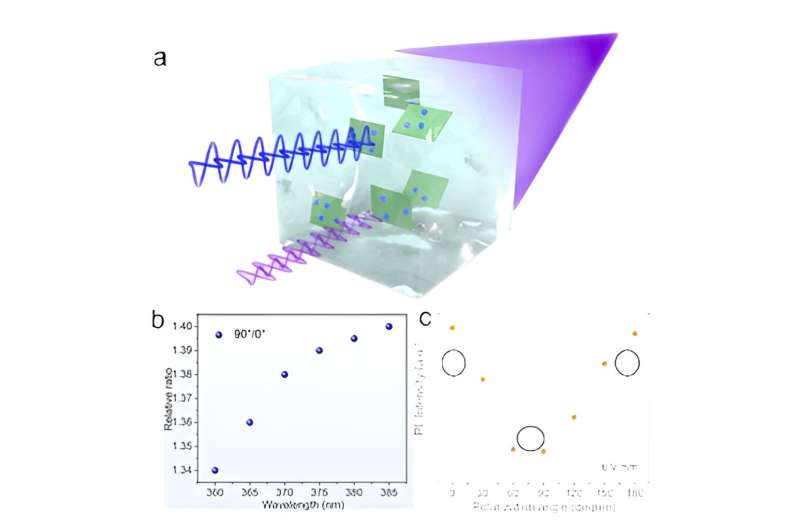The generation, modulation, and detection of polarized light play a pivotal role across diverse fields, including optical communication, laser processing, dynamic displays, and biomedical imaging. The advancement of multifunctional prototype devices, seamlessly integrating an array of optical control technologies, holds great potential to address the future requirements of polarized optics, emphasizing low power consumption, functional integration, and cost-effective optical components.
Polarized luminants encompass the dual attributes of light emission and optical modulation, presenting many distinctive advantages, including polarized light emission and adaptive optical modulation. Nevertheless, conventional organic polarized luminants encounter one or more challenges, such as insensitivity to external fields, low luminous efficiency, or inadequate ultraviolet optical stability.
The innovation of novel luminants, characterized by heightened sensitivity to external fields, stability within the deep ultraviolet wavelength range, and elevated luminous efficiency, assumes paramount significance for the fabrication of multifunctional optical control devices. Owing to their nano-scale dimensions in one or more dimensions, low-dimensional inorganic materials manifest distinct physical properties in contrast to bulk materials, including pronounced quantum confinement effects and substantial optical anisotropy.
Specifically, composite heterostructures derived from materials with disparate dimensions unveil exceptional electrical, magnetic, catalytic, and photochemical properties, showcasing remarkable performance in pertinent applications. Nevertheless, advancements in the field of polarized luminants are still hindered, mainly ascribed to challenges associated with immature construction technology of composite heterostructures and the absence of complementary property characteristics among materials of varying dimensions.
In a new paper published in Light: Science & Applications, a team of scientists led by Baofu Ding, Feng Wang, and Hui-Ming Cheng from the Shenzhen Institutes of Advanced Technology, Chinese Academy of Sciences, Guangdong, China, and co-workers integrated ultra-high stimulus-sensitive wide-bandgap 2D materials with 0D carbon quantum dots (CDs), showcasing highly efficient and polarized blue fluorescence.
This synthesis results in the creation of the inaugural all-inorganic nano-heterostructure luminant characterized by a 0D/2D configuration. Moreover, multifunctional devices based on the 0D/2D nano-heterostructure luminant seamlessly amalgamate the functionalities of emission, modulation, and light detection.

The crux of establishing the 0D/2D hetero-structured luminant lies not only in the effective anchoring of components with different dimensional materials but also in ensuring their optical characteristics harmonize seamlessly. To circumvent the potential absorption quenching of the excitation and emission light of 0D luminescent materials by 2D materials, the research team employed cobalt-doped titanium dioxide (CTO) dispersion, characterized by a wide bandgap and high field sensitivity, as the foundational element.
Through the chemisorption-induced formation of Ti-O-C bonds, the team successfully synthesized a colloidal solution of CDs/CTO heterojunction. This colloidal solution aptly retained the optically anisotropic properties of CTO and the efficient blue luminescent characteristics of CDs, indicating the successful construction of the premier all-inorganic CDs/CTO hetero-structured luminant.
Built upon the developed hetero-structured luminant, exploiting the heterojunction’s dichroic absorption properties of the optical device facilitates the detection of ultraviolet light within the range of 360 nm to 385 nm. The polarized emission of CDs is attained through the oriented arrangement induced by CTO, signifying the successful establishment of a multifunctional optical control prototype device seamlessly integrating modulation, emission, and detection.
The research outcome introduces a new member to the polarized luminant family, presenting a fresh perspective and innovative methodologies for developing diverse hetero-structured luminants. The amalgamation of these properties offers a tangible prototype device for optical modulation and detection, along with polarized luminescent manipulation. The finding will be potentially applicable in diverse fields such as photocatalysis, biomedical application, display and optical communication in the future.
More information:
Hongwei Xu et al, A multifunctional optoelectronic device based on 2D material with wide bandgap, Light: Science & Applications (2023). DOI: 10.1038/s41377-023-01327-8
Citation:
Polarized hetero-structured luminant: The ‘marriage’ of 2D materials and 0D quantum dots (2023, December 4)
retrieved 6 December 2023
from
This document is subject to copyright. Apart from any fair dealing for the purpose of private study or research, no
part may be reproduced without the written permission. The content is provided for information purposes only.

